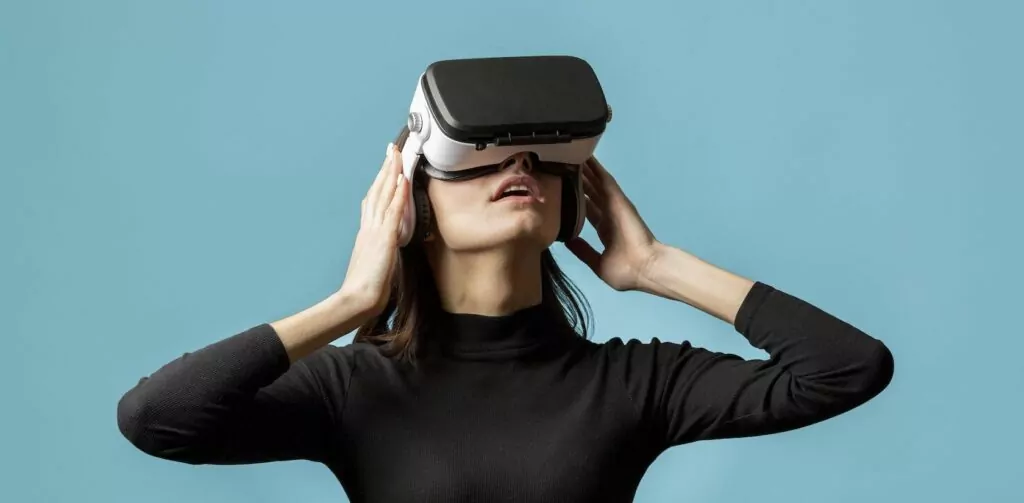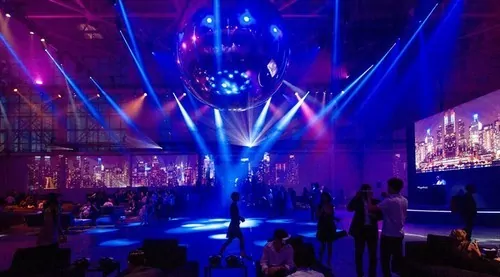In the tech universe, Virtual Reality (VR) emerges as a groundbreaking invention, transforming our engagement with online worlds. This piece takes a deep dive into VR’s domain, shedding light on its essence, software complexities, the journey of its initiation, choice of software, vital equipment, and the continually changing panorama of this thrilling area.
When diving into the intricate world of VR, the hardware forms the backbone of any immersive experience. AJProTech’s prowess in hardware engineering positions us as the go-to partner for VR hardware development. Our team’s deep understanding of electronics, combined with state-of-the-art facilities, allows us to design and produce high-quality VR technology tailored to your needs. Moreover, our holistic approach to product development, from technology research to production validation, ensures a smooth and efficient process. By choosing AJProTech, you’re not just selecting a service provider; you’re partnering with a leader in VR hardware innovation. So today we invite you to learn about the features of VR development firsthand.
Contents
- 1 Defining VR Development
- 2 Understanding VR Software development
- 3 Role in Shaping Virtual Environments
- 4 Initiating Your Journey into Virtual Reality Development
- 5 Choosing the best VR Software for Virtual Reality Projects
- 6 Utilizing Software Development Tools in VR Programming
- 7 Conclusion
- 8 FAQ about VR Development
Defining VR Development
VR developers focus on Virtual Reality (VR) Development, which is the vibrant and imaginative endeavor of shaping, crafting, and building digital spaces. These spaces can mimic real-life scenarios or go beyond the known boundaries of creativity. The development process involves utilizing cutting-edge technology to replicate sensory feedback, visuals, and user engagement. .
This allows individuals to fully immerse themselves in the experience, often through the use of dedicated gear such as VR goggles or VR headsets like the Oculus Rift. The field of VR Development incorporates 3D designs, soundscapes, programming, and user engagement, crafting mesmerizing virtual journeys that whisk users to uncharted terrains.
Understanding VR Software development
The bedrock of immersive virtual journeys lies in VR software development, turning dreams and realities into palpable VR content experiences. This section unravels the enigmatic world of VR software, highlighting its importance, capabilities, and pivotal role in sculpting immersive virtual realms.
Importance of VR Software
VR applications act as the nexus that links human engagement with digital worlds. They streamline the melding of visual graphics, sound signals, and interaction facets, culminating in a meticulously crafted virtual realm. Such software gives developers the prowess to design spaces that enthrall users’ senses and feelings, seamlessly merging the tangible with the intangible.
Features of VR Software:
In essence, VR software addresses a diverse array of functionalities that synergistically integrate to produce captivating and fluid experiences:
- 3D Design and Illumination: Through VR software, especially in game development, developers can fabricate detailed 3D designs for VR games, infusing virtual spaces with vivid authenticity.
- Real-world Dynamics Simulation: This software introduces the possibility of real-world physics simulations, ensuring natural behavior of entities within the digital ambiance.
- User Interaction: The essence of VR, especially in game development, lies in user connectivity.
- Sound Integration: Acoustics, especially in game development and VR games, are instrumental in deepening immersion.
- Visual Rendering: Software, including tools for VR, fine-tunes visual projections to align with VR headset capabilities, such as Google Cardboard or Oculus Rift, promising fluid and graphically appealing experiences in both virtual and mixed reality realms.
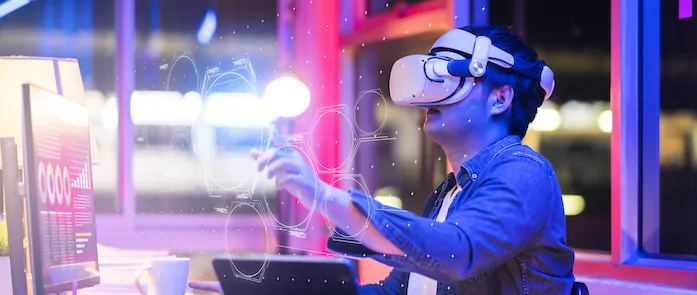
Role in Shaping Virtual Environments
VR software equips creators to transform innovative ideas into palpable digital scenarios. From sketching detailed terrains to scripting dynamic engagements and tailoring user navigations, platforms like Unity3D and Unreal Engine grant the tools to bring visionary ideas to life. These ecosystems present intuitive dashboards, expansive asset collections, and potent VR-focused development tools, trimming the developmental phase while boosting the caliber of the end creation.
Initiating Your Journey into Virtual Reality Development
Setting foot into the vast expanse of Virtual Reality (VR) app development is a venture towards weaving immersive universes and transcending tech frontiers. This segment is your compass, delineating the foundational strides and pivotal aspects to ignite your foray into this mesmerizing domain.
- Understanding VR Basics: Before you immerse yourself in VR’s complex world, it’s paramount to grasp the bedrock ideas of virtual reality. Grasp notions like spatial perception, interaction strategy, and the significance of sensory feedback in forging immersive tales.
- Dive into 3D Modeling and Illustration: Being proficient in 3D modeling is pivotal for crafting the digital realms your audience will journey through. Delve into techniques in modeling, texture applications, and illuminations to mold lifelike and visually enticing virtual stages.
- Get Acquainted with Coding Essentials: While deep coding expertise isn’t a prerequisite, a familiarity with languages like C# or C++ can give you a considerable edge. Scripting infuses vibrancy into your VR stories, lending them fluidity and allure.
- Navigate the Digital Knowledge Ocean: The web is brimming with VR tools and assets for budding VR visionaries. Sift through online guides, visual lessons, and dedicated VR forums. Portals like Udemy, Coursera, and YouTube furnish in-depth modules that fortify your foundational skills.
- Connect with VR Enthusiasts: Forge bonds within VR circles, development company networks, and digital forums to connect with individuals driven by a shared zeal. Such hubs are golden for inquiries, swapping discoveries, and drawing wisdom from seasoned creators.
- Tinker with VR development tools: On your learning curve, play around with tools such as Unity3D or Unreal Engine, which are popular VR software development tools. These toolkits offer user-friendly dashboards, ample creative assets, and tailored VR capabilities simplifying the crafting trajectory.
- Embark on Petite Endeavors: Kickstart your odyssey with bite-sized experience VR challenges. Forge engaging vignettes, VR applications, dabble in rudimentary gaming sketches, or focus on specific augmented reality facets. As your confidence swells, venture into grander narratives.
- Seek Feedback and Refinement: Constructive critiques are gold mines for skill refinement. Showcase your creations to contemporaries and guides, and embrace growth-oriented reviews. Harness this insight to polish your undertakings and deepen your VR developmental acumen.
- Remain Inquisitive and Flexible: The VR development sphere is constantly shifting. Nurture a sense of wonder towards novel methodologies, tools, and evolutions. Embrace alterations, tinker with the latest utilities, and consistently polish your expertise to stay in the vanguard of technological evolution.
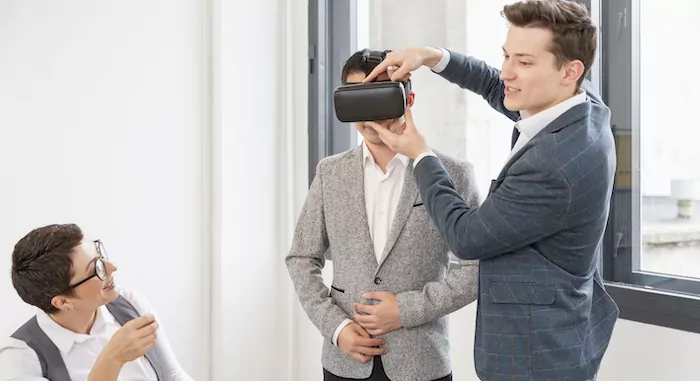
Choosing the best VR Software for Virtual Reality Projects
Selecting the ideal software significantly impacts your Virtual Reality (VR) undertakings. In this segment, we’ll dissect the criteria, choices, and crucial aspects that steer you in pinpointing the perfect software suite for your VR quests.
Define Your VR project Blueprint
Prior to assessing virtual reality software development tools and alternatives, draft the objectives and prerequisites of your VR endeavor. Weigh elements like the intricate nature of the venture, interaction depth, target demographics, and accessible resources.
Survey Dominant VR Hubs:
Unity3D, Unreal Engine, Samsung Gear VR, and Playstation VR are the titans in the VR software arena. Each boasts potent functionalities, user-friendly dashboards, and a rich software development kit, making them prime candidates for VR initiations.
Unity 3D
- Straightforward Dashboard: Unity is renowned for its beginner-friendly layout, serving both novices and seasoned artisans.
- Rich Resource Repository: Unity’s marketplace is stocked with a diverse array of ready-to-use components, scripts, and utilities, streamlining the crafting phase.
- Universal Hardware Support. Unity caters to multiple VR gear, including VR engines, broadening your build VR project’s reach.
Unreal Engine
- Superior Graphic Finesse: Unreal Engine’s prowess in rendering visuals sets it apart, making it ideal for high-definition VR tales.
- Blueprint Visual Crafting: Unreal’s Blueprint system offers a coding alternative, especially handy for those less versed in classical programming.
- Cinematic Excellence: Unreal’s cinematic emphasis can infuse unparalleled immersion into your VR narrative.
Tailored VR solutions and Elements
Both Unity and Unreal Engine present VR-centric software solutions and VR SDKs that enhance the immersive quotient. Seek utilities that offer 3D sound, real-time illumination, realistic simulations, and interaction dynamics fine-tuned for VR milieus.
Community and Knowledge Base
Factor in the strength of the VR market community and the depth of available literature. Vibrant communities, step-by-step tutorials, and problem-solving guides can be lifelines as you decipher software intricacies and confront challenges.
Efficiency Refinement
Seamless VR execution requires adept optimization. Favor software equipped with performance analysis and refining tools, assuring fluid renditions across diverse VR apparatuses.
Expense Dynamics
Unity, Unreal Engine, and popular VR platforms like Oculus present gratis editions with certain confines, alongside subscription models boasting enriched features for best VR development. Align your fiscal limits with the essential functionalities while deciding on a package.
Adaptability Quotient
Assess your comfort level with the software contenders. Unity typically offers a gentler learning gradient, whereas Unreal Engine, with its superior visual prowess, can pose a more intricate learning journey.
Prospective Expansion and incorporate of VR strategies
Contemplate the future trajectory of your development projects and create a VR venture. Opt for software that resonates with your long-haul aspirations, be it for crafting modest narratives or grand, expansive odysseys.

Utilizing Software Development Tools in VR Programming
Delving into the universe of AR and VR software development necessitates an ensemble of powerful VR tools and a range of tools. These instruments form the nexus between the developer’s creative vision and the tangible, immersive worlds they craft. Let’s journey through the pivotal tools that are instrumental in shaping, refining, and enhancing VR experiences.
Sculpting the Digital Realm with 3D Modeling Software and Google VR SDK
Applications like Blender, Maya, and 3ds Max are the VR game developer’s chisel and hammer, allowing them to mold detailed landscapes, lifelike characters, and dynamic objects that provide a virtual experience in the VR universe.
VR Architectural Hubs (Unity3D and Unreal Engine)
These giants of the VR ecosystem offer a holistic workshop:
- Scene Studios: Visual canvases enabling placement, alignment, and coordination of VR elements.
- Resource Repositories: Treasure troves of ready-to-deploy assets, enhancing development speed and variety.
- Coding Suites: Languages like C# or visual environments like Blueprint, animate and energize the VR realm.
- Physical Dynamics Simulators: Impart real-world motion, gravity, and interactivity to digital entities.
Charting Logic with Visual Scripting Tools
A boon for the non-coders, visual scripting interfaces empower the creation of complex mechanics through intuitive drag-and-drop interfaces, breaking down barriers to innovation.
Orchestrating Realms with Audio Integration Software
The symphonies of VR are composed with tools like FMOD and Wwise. These orchestrate 3D auditory experiences, wrapping users in layers of sound, from subtle ambient noises to dramatic thematic scores.
Chronicles of Creation with Version Control Systems
Git and similar platforms pen the evolving story of VR creations, allowing artisans to collaborate, iterate, and trace their journey of development.
Immersing in Digital Realities with VR Hardware
Headsets, controllers, and sensory apparatus are the gateways. They allow developers to step into their creations, refining and tweaking them based on firsthand experience.
Tuning VR Experiences with Profiling and Optimization Tools
The magnifying glasses of the VR world, these tools spotlight areas demanding refinement, ensuring fluidity and immersion, irrespective of the device.
Crafting Digital Interactions with UI Design Instruments
Design applications like Adobe XD and Sketch weave the fabric of user interfaces, ensuring that explorers can navigate the VR cosmos with intuition and ease.
Anchoring Knowledge with Documentation
From official manuals to community-driven forums and lessons, these resources illuminate the path of mastery, clarifying doubts and imparting wisdom.
Collaboration and Communication Tools
Digital ateliers like Slack, Trello, and Microsoft Teams are the hives, buzzing with collaborative energy, ensuring a harmonized rhythm in the VR creation ballet.
An artist’s palette brimming with diverse shades, this toolkit aids in painting vast, interactive canvases in the virtual cosmos. It’s through the skilled melding of these tools that developers can articulate their vision, shaping nebulous ideas into tangible, awe-inspiring virtual worlds. Embracing and mastering this toolkit is akin to learning a new language, one that speaks directly to the senses, beckoning explorers into realms previously only dreamt of.
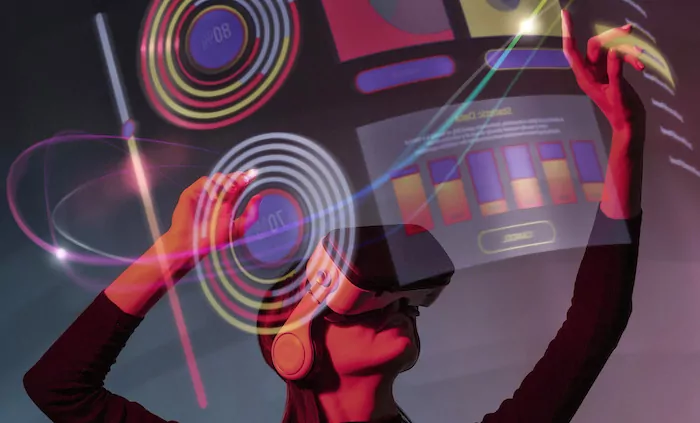
Conclusion
Virtual Reality Development is a dynamic field that opens doors to boundless creativity. By leveraging cutting-edge techniques and software, developers can bring captivating virtual worlds to life. As VR technology continues to evolve, the possibilities for crafting immersive experiences are limitless.
In the realm of Virtual Reality (VR), AJProTech stands out as a pioneer in full-cycle development, seamlessly integrating both hardware and software components to craft immersive VR experiences. Our expertise in electronics design and hardware engineering ensures that every VR product we develop is not only innovative but also robust and reliable. From conceptualizing the VR idea to mass production, our dedicated team ensures that every step is meticulously executed. With the rapid evolution of VR technology, partnering with AJProTech ensures that you’re working with a team that’s at the forefront of the latest advancements, ensuring your VR products are cutting-edge.
FAQ about VR Development
What does the process of VR development involve?
VR development involves several steps, including conceptualizing the virtual environment, creating 3D models, coding interactive elements, integrating audio and visuals, testing for functionality, and optimizing the experience for various VR devices.
Is the field of VR still evolving?
VR technology is rapidly evolving. New hardware advancements, software updates, and innovative VR apps continue to reshape the development landscape, offering developers fresh challenges and opportunities.
Which programming languages are used for coding in VR?
Common programming languages for VR development include C#, C++, and Python. These languages enable developers to create VR, build interactive elements, simulate physics, and provide immersive experiences within virtual environments.
How is VR used in product development?
At AJProTech, we see tremendous potential in using Virtual Reality (VR) technology to revolutionize product development. By creating virtual replicas in a simulated metaverse, developers can effortlessly assess the strengths and weaknesses of the devices, and test ergonomics, aesthetics, and user interactions. This enables swift enhancements to elevate the user experience and perfect the device’s design. At AJProTech, we envision the power of VR to revolutionize product development, inspiring innovation and delivering unparalleled user satisfaction.


